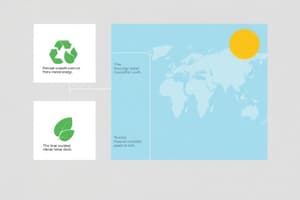Podcast
Questions and Answers
What is the primary focus of the emphasis principle in design?
What is the primary focus of the emphasis principle in design?
- Maintaining uniformity across all components
- Creating visual contrast between elements
- Directing attention towards a specific focal point (correct)
- Establishing a harmonious relationship in design
In which type of design is usability and aesthetics a primary concern?
In which type of design is usability and aesthetics a primary concern?
- Graphic Design
- Fashion Design
- Interior Design
- Product Design (correct)
Which principle of design is concerned with the size relationship between elements?
Which principle of design is concerned with the size relationship between elements?
- Proportion (correct)
- Balance
- Hierarchy
- Contrast
What is the first step in the design process?
What is the first step in the design process?
Which of the following software is NOT typically used for graphic design?
Which of the following software is NOT typically used for graphic design?
What does the principle of unity imply in a design?
What does the principle of unity imply in a design?
Which design type focuses primarily on creating layouts for digital platforms?
Which design type focuses primarily on creating layouts for digital platforms?
What is the role of testing in the design process?
What is the role of testing in the design process?
Flashcards are hidden until you start studying
Study Notes
Definition of Design
- Design is the process of creating a plan or convention for the construction of an object or a system.
- It encompasses a wide range of activities, including engineering, architecture, graphic design, and fashion.
Key Principles of Design
-
Balance
- Symmetrical (even distribution) or asymmetrical (uneven distribution) balance.
-
Contrast
- Use of opposing elements (colors, shapes) to create visual interest.
-
Emphasis
- Focusing attention on a focal point or key element in the design.
-
Unity
- Cohesiveness in the design where all elements work together harmoniously.
-
Proportion
- The size relationship between different elements in a design.
-
Hierarchy
- Organizing elements to show their importance or order.
Types of Design
-
Graphic Design
- Visual content creation for print and digital media.
-
Product Design
- Development of physical products with usability and aesthetics in mind.
-
Interior Design
- Designing interior spaces to enhance functionality and aesthetics.
-
Fashion Design
- The creation of clothing and accessories based on trends and personal expression.
-
Web Design
- Designing websites focusing on layout, user experience, and aesthetics.
Design Process
-
Research
- Gather data and insights about the problem or opportunity.
-
Ideation
- Brainstorm ideas and concepts to address the design challenge.
-
Prototyping
- Create preliminary models or versions of the design.
-
Testing
- Evaluate prototypes for usability and functionality.
-
Implementation
- Finalize and execute the design solution.
Tools and Software
- Graphic Design: Adobe Photoshop, Illustrator, Canva.
- Product Design: CAD software, SolidWorks.
- Web Design: HTML/CSS, WordPress, Adobe XD.
Importance of Design
- Enhances user experience and usability.
- Conveys messages effectively through visual communication.
- Drives innovation and problem-solving across various fields.
Definition of Design
- Design involves creating a blueprint or framework for constructing objects or systems.
- It spans various fields including engineering, architecture, graphic design, and fashion.
Key Principles of Design
- Balance
- Can be symmetrical (equal distribution) or asymmetrical (unequal distribution) to achieve visual stability.
- Contrast
- Integrates opposing elements such as colors and shapes to captivate viewer interest.
- Emphasis
- Directs focus to a specific focal point or critical design element.
- Unity
- Ensures all components in a design work together cohesively for a harmonious effect.
- Proportion
- Examines the size relationships between different design elements to ensure visual appeal.
- Hierarchy
- Organizes design elements to establish their importance and sequence effectively.
Types of Design
- Graphic Design
- Creates visual content for both printed and digital platforms.
- Product Design
- Develops tangible products prioritizing usability and aesthetic appeal.
- Interior Design
- Focuses on optimizing interior spaces to enhance both functionality and visual aesthetics.
- Fashion Design
- Involves designing clothing and accessories reflecting current trends and individualism.
- Web Design
- Centers on creating user-friendly and visually appealing website layouts.
Design Process
- Research
- Involves collecting data and insights to understand the design challenge.
- Ideation
- The brainstorming phase where various ideas and concepts are generated.
- Prototyping
- Development of initial models or versions to visualize the design concept.
- Testing
- Assessment of prototypes to gather feedback on usability and functionality.
- Implementation
- Finalizes and executes the approved design solution.
Tools and Software
- Graphic Design: Utilizes tools like Adobe Photoshop, Illustrator, and Canva.
- Product Design: Employs CAD software and SolidWorks for product development.
- Web Design: Involves coding languages like HTML/CSS and platforms such as WordPress and Adobe XD.
Importance of Design
- Improves user experience and functionality across various applications.
- Facilitates effective communication through visual elements and graphic representation.
- Fosters innovation and problem-solving capabilities within diverse industries.
Studying That Suits You
Use AI to generate personalized quizzes and flashcards to suit your learning preferences.




